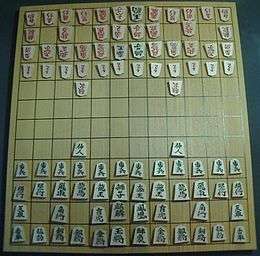Trishogi
Trishogi is a shogi variant for two players created by George R. Dekle Sr. in 1987.[1][2] The gameboard comprises 9×10 interlocking triangular cells. The game is in all respects the same as shogi, except that piece moves have been transfigured for the triangular board-cell geometry.
Trishogi was included in World Game Review No. 10 edited by Michael Keller.[3]
Game rules
Trishogi has the same types and numbers of pieces as shogi, and all normal shogi rules apply, including initial setup (see diagram), drops, promotion, check, and checkmate. As in shogi, pieces capture the same as they move. But the triangular geometry creates special move patterns for the pieces.
Piece moves
The diagrams show how the unpromoted pieces move. As in shogi, a dragon king (promoted rook) moves as a rook and as a king. A dragon horse (promoted bishop) moves as a bishop and king.
See also
- Shogi variants
- Also by George Dekle:
- Hexshogi—a variant with hexagonal cells
- Masonic Shogi
- Space Shogi—a 3D variant
- Triangular Chess—a chess variant with triangular cells
References
- Pritchard (1994), p. 324
- Pritchard (2007), p. 260
- Keller, Michael, ed. (June 1991). "A Panorama of Chess Variants". World Game Review. No. 10. Michael Keller. ISSN 1041-0546.
Bibliography
- Pritchard, D. B. (1994). The Encyclopedia of Chess Variants. Games & Puzzles Publications. ISBN 0-9524142-0-1.CS1 maint: ref=harv (link)
- Pritchard, D. B. (2007). Beasley, John (ed.). The Classified Encyclopedia of Chess Variants. John Beasley. ISBN 978-0-9555168-0-1.CS1 maint: ref=harv (link)
